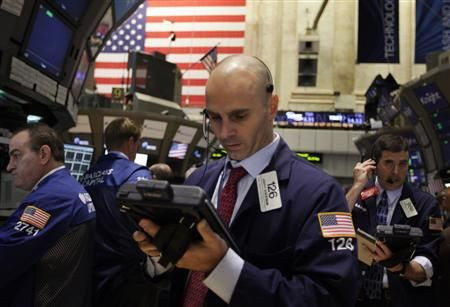It Didn’t Take Much to Rescue U.S. Stocks From Bear Status
ANALYSIS

U.S. stocks were saved from bear market territory and it didn't even take that much.
During Tuesday's morning session, the S&P 500 declined to 1,074 at one point, which is about 22 percent below its May 2 intra-day high of 1,370. A commonly accepted metric of a bear market is dropping more than 20 percent over several months.
Late in the afternoon, the S&P 500 still hovered around 1,080. Then it surged and closed at 1,123.95 for a gain of 2.25 percent.
The Dow Jones Industrial Average closed up 1.44 percent and the Nasdaq Composite climbed up 2.95 percent.
U.S. stocks and other risk assets rallied on a Financial Times reported that European Union finance ministers are discussing ways to recapitalized European banks.
Although the details of the plan are still under discussion, officials said EU ministers meeting in Luxembourg had concluded that they had not done enough to convince financial markets that Europe's banks could withstand the current debt crisis, reported FT.
The market's dramatic reaction to the FT report highlights several points.
European Debt Crisis
It shows that global markets clearly care about the European debt crisis, just like how it cared about the U.S. subprime mortgage crisis.
What's at stake is a banking meltdown stemming from potential losses on the government bonds of Greece and other peripheral European countries.
It also shows how easily it is to give the market hope and potentially end the crisis.
Adequately capitalizing European banks would go a long way. Throwing more money at the problem, like the Eurozone has done in the past, would also help.
What would also solve the problem is Eurozone integration, starting with the introduction of euro-bonds.
All of these moves are feasible if the Eurozone can only muster the political will to push them through.
U.S. Economic and Budget Crisis
The U.S. is in a similar situation.
Two huge problems it faces are the long-term budget deficit and short-term economic sluggishness.
If Washington were effective, it could solve both problems in a grand bargain involving short-term stimulus in exchange for long-term structural spending reforms.
It's also easy for U.S. policymakers to boost financial asset prices (whether or not doing so is a good idea is another debate). All the Federal Reserve has to do is print more money.
What Will the Market do?
What cannot be easily fixed, however, is the ongoing process of deleveraging in the developed world, growth-crippling austerity measures in Europe, and global trade imbalances.
These structural problems cast a dark shadow over the global economy.
Absent any positive news, global markets will likely stagnate or decline as spooked investors move to safe-haven assets.
However, because authorities still have several relatively low-hanging fruit policy tools to boost the economy and markets, investors should watch for big policy moves.
Depending on how major they are, they have the ability to spark market rebounds or even a sustained market rally.
This is what happened in 2010.
With the U.S. economy and markets faltering, the government came to the rescue and sparked a rebound with the announcement of QE2 and a mini-fiscal stimulus package.
© Copyright IBTimes 2024. All rights reserved.





















